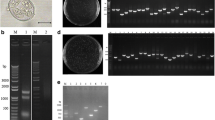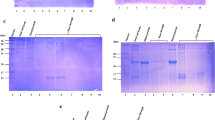Abstract
Coccidiosis is a widely distributed disease with higher mortality and morbidity, which is caused by several species of protozoan parasites belonging to the genus Eimeria and recognized as a serious challenge for the poultry industry. This research was conducted to construct the recombinant plasmid pET32a(+)-ADF-linker-3-1E of Eimeria acervulina (E. acervulina) of the chicken and test the bioactivity of the ADF-linker-3-1E protein. The ADF-linker-3-1E gene of E. acervulina of the chicken was cloned by splicing by overlap extension by the polymerase chain reaction (SOE-PCR) and then inserted into the pET32a(+) to construct the recombinant plasmid pET32a(+)-ADF-linker-3-1E. The recombinant plasmid was transformed into Escherichia coli Rosetta (DE3) competent cells and then induced by IPTG (0.6 mmol/L). The expressed product in the culture medium was identified by the sodium dodecyl sulfate-polyacrylamide gel electrophoresis (SDS-PAGE). The bioactivity of the ADF-linker-3-1E protein was tested by Western blotting. The result showed that the amplified ADF-linker-3-1E gene was about 1346 bp. The PCR amplification with the recombinant plasmid pET-32a(+)-ADF-linker-3-1E as a template resulted in a special band of 1346 bp. The digested products resulted in two fragments of 1346 bp target fragment and 5.9 kb pET-32a(+)-vector fragment. The results indicated that the ADF-linker3-1E gene was successfully inserted into the pET-32a(+)-vector. The expressed products in the culture medium resulted in a single band of approximately 54.8 kDa by SDS-PAGE. Western blotting analysis indicated that the recombinant protein could be reacted specifically with His-Tag(2A8) Mouse mAb. This study indicated that the ADF-linker-3-1E protein with good bioactivity was successfully obtained, which laid a foundation for the exploitation of the nuclear vaccine by using the ADF-linker-3-1E protein.








Similar content being viewed by others
References
Allen ML, Dobrowolski JM, Muller H (1997) Cloning and characterization of actin depolymerizing factor from Toxoplasma gondii. Mol Biochem Parasitol 88(1–2):43–52
Augustine PC (2001) Cell: sporozoite interactions and invasion by apicomplexan parasites of the genus Eimeria. Int J Parasitol 31(1):1–8
Belli SI, Ferguson DJP, Katrib M, Slapetova I, Mai K, Slapeta J, Flowers SA, Miska KB, Tomley FM, Shirley MW, Wallach MG, Smith NC (2009) Conservation of proteins involved in oocyst wall formationin Eimeria maxima, Eimeria tenella and Eimeria acervulina. Int J Parasitol 39(10):1063–1070
Dalloul RA, Lillehoj HS (2006) Poultry coccidiosis: recent advancements in control measures and vaccine development. Expert Rev Vaccines 5(1):143–163
Dawn MW, Joann S, Kuhlenschmidt MS, Dubey JP, Sibley LD (2005) Gliding motility leads to active cellular invasion by Cryptosporidium parvum Sporozoites. Infect Immun 73(9):5379–5387
Ding J, Bao W, Liu Q, Yu Q, Abdille MH, Wei Z (2008) Immunoprotection of chickens against Eimeria acervulina by ecombinant alpha-tubulin protein. Parasitol Res 103(5):1133–1140
Haberkorn A (1996) Chemotherapy of human and animal coccidioses: state and perspectives. Parasitol Res 82(3):193–199
Lillehoj HS, Lillehoj EP (2000) Coccidiosis:A review of acquired intestinal immunity and vaccination strategies. Avian Dis 44(2):408–425
Lillehoj HS, Choi KD, Jenkins MC, Vakharia VN, Song KD, Han JY, Lillehoj EP (2000) A recombinant Eimeria protein inducing interferon-gamma production: comparison of different gene expression systems and immunization strategies for vaccination against coccidiosis. Avian Dis 44(2):379–389
Lu JX, Zhao YL, Bao YZ, Zhu YT, Gao Y, Qin JH (2009) Cloning and sequence analysis of 3-1E gene of merozoites of Eimeria acervulina Baoding strain isolated from Hebei province of China. Chinese J Vet Sci 29(9):1278–1281 (in Chinese)
Ma D, Ma C, Pan L, Li G, Yang J, Hong J, Cai H, Ren X (2011) Vaccination of chickens with DNA vaccine encoding Eimeria acervulina 3-1E and chicken IL-15 offers protection against homologous challenge. Exp Parasitol 27(1):208–214
McDonald V, Shirley MW (2009) Past and future: vaccination against Eimeria. Parasitol 136(12):1477–1489
Min W, Dalloul RA, Lillehoj HS (2004) Application of biotechnological tools for coccidia vaccine development. J Vet Sci 5(4):279–288
Rose ME, Hesketh P (1976) Immunity to coccidiosis: stages of life cycle of Eimeria maxima which induce and affected by the response of the host. Parasitology 73(1):25–57
Schuler H, Mueller AK, Matuschewski K (2005) A Plasmodium action depolymerizing factor that binds exclusively to actin monomers. Mol Biol Cell 16(9):4013–4023
Song KD, Lillehoj HS, Choi KD, Yun CH, Parcells MS, Huynh JT, Han JY (2000) A DNA vaccine encoding a conserved Eimeria protein induces protective immunity against live Eimeria acervulina challenge. Vaccine 19(2–3):243–252
Song X, Xu L, Yan R, Huang X, Shah MA, Li X (2009) The optimal immunization procedure of DNA vaccine pcDNA-TA4-IL-2 of Eimeria tenella and its cross-immunity to Eimeria necatrix and Eimeria acervulina. Vet Parasitol 159(1):30–36
Vermeulen AN (1998) Progress in recombinant vaccine development against coccidiosis: a review and prospects into the next millennium. Int J Parasitol 28(7):1121–1130
Vermeulen AN, Schaap DC, ThSchetters PM (2001) Control of coccidiosis in chickens by vaccination. Vet Parasitol 100(1–2):13–20
Wetzel DM, Schmidt J, Dubey JP, Kuhlenschmidt MS, Sibley LD (2005) Gliding motility leads to active cellular invasion by Cryptosporidium parvum sporozoites. Infect Immun 73(9):5379–5387
Xu JH, Qin ZH, Liao YS, Xie MQ, Li AX, Cai JP (2008) Characterization and expression of an actin-depolymerizing factor from Eimeria tenella. Parasitol Res 103(2):263–270
Yamashiro S, Mohri K, Ono S (2005) Two Caenorhabditis elegans actin depolymerizing factor/cofilin proteins differently enhance actin filament severing and depolymerization. Biochem 44(43):14238–14247
Zhang J, Liu YW, Yue Z, Ji XY, Ma TY, Zhao YL, Bao YZ, Qin JH (2015) Study of the immunogenicity and prokaryotic expression of ADF gene of Eimeria acervulina. Chinese J Vet Sci 35(2):229–234 (in Chinese)
Zhao YL, Wang CM, Lu YM, Amer S, Xu P, Wang JY, Lu JX, Bao YZ, He HX, Qin JH (2011) Prokaryotic expression and identification of 3-1E gene of merozoite surface antigen of Eimeria acervulina. Parasitol Res 109(5):1361–1365
Zhao YL, Bao YZ, Zhang LJ, Chang LY, Jiang LF, Liu YW, Zhang L, Qin JH (2013) Biosafety of the plasmid pcDNA3-1E of Eimeria acervulina in chicken. Exp Parasitol 133(3):231–236
Acknowledgments
This research was supported by grants from the National Natural Science Foundation of China (grant number 30571394) and the National Natural Science Foundation of Hebei province (grant number C2007000523).
Author information
Authors and Affiliations
Corresponding author
Additional information
Zhao Yuelan and Liu Yiwei contributed equally to this work.
Rights and permissions
About this article
Cite this article
Yuelan, Z., Yiwei, L., Liyuan, L. et al. Expression and identification of the ADF-linker-3-1E gene of Eimeria acervulina of chicken. Parasitol Res 115, 1641–1647 (2016). https://doi.org/10.1007/s00436-016-4903-y
Received:
Accepted:
Published:
Issue Date:
DOI: https://doi.org/10.1007/s00436-016-4903-y




